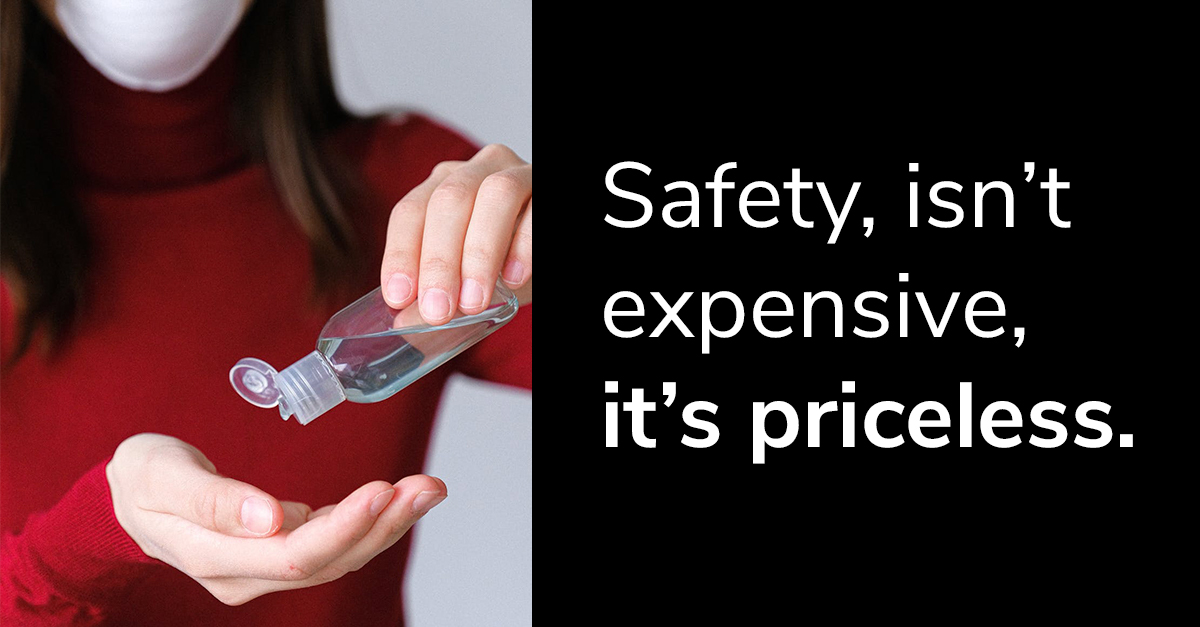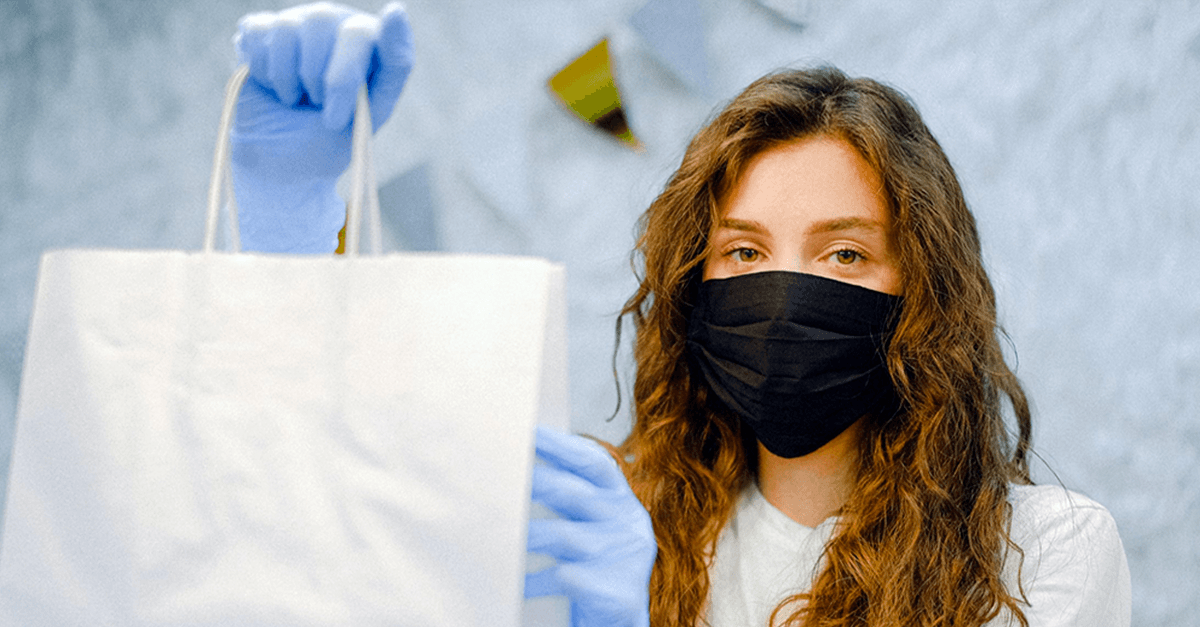After over two months of lockdowns across the United States, our ongoing consumer studies show that while consumers remain worried about coronavirus, the level of concern is slowly decreasing. Still, the majority of shoppers report that they do not feel safe participating in basic in-store activities including trying on clothes in dressing rooms, working with a sales associate, and testing beauty products. As shoppers begin to reemerge from their homes, it is important that retailers and brands do what they can to make them feel safe in store.
We asked consumers to rank which precautions made them feel the safest when shopping in-store, and this is what they told us.
#1. Hand Sanitizer
80% say having hand sanitizer in-stores makes them feel safer while shopping.
It is widely known that disinfectants like alcohol and bleach can kill Coronavirus pathogens. What better way to help consumers stay safe than provide an antiviral solution in stores? Let’s face it, refraining from touching your face, adjusting your mask, or scratching that irritating itch can be a challenge. Having hand sanitizer is an effective way to safely reduce the risk of infection.
#2. Limiting the Number of People Allowed In-Store
80% say limiting the number of people in-store makes them feel safer while shopping.
The CDC recommends that customers have at least 6 feet of distance in between them—about two arms’ lengths—to prevent the virus from spreading to others as easily. This can be a challenge in a store without capacity limitations that becomes over-crowded. Limiting the number of people in-store allows customers to feel less threatened by others in close proximity.
#3. Wearing a Face Mask
79% say wearing a face mask in-store makes them feel safer while shopping.
It’s generally the customer’s responsibility to wear a face mask or face covering. Some regions even make wearing masks in public mandatory. However, in the instance that a customer forgets to bring a mask or does not have one on hand, it is important to establish a position. Will you allow those without masks to enter your stores?
Another consideration is whether you want to provide face masks to those without. While our most recent study shows that 80% of consumers prefer to wear their own face masks, those who need one are likely open to using one provided in-store –especially if it allows them entrance. If cost is an issue, some stores request a small $1 or $2 donation for a store-provided mask.
#4. Providing Curbside Pickup or Buy Online Pickup In-Store
77% say Curbside Pickup or BOPIS makes them feel safer while shopping.
For those who do not feel comfortable shopping in-store yet, providing Curbside Pickup or “Buy-Online-Pickup-In-Store” helps regain their traffic. If you have yet to offer this as an option, consider the best ways to educate your customers on the process. Will they need to download an app, order online, or simply call a phone number? Do they need to prepay with credit card or is payment accepted on-site? Education is a critical step for a successful Curbside Pickup or BOPIS program.
#5. No-Contact Payment
77% say No-Contact Payment makes them feel safer while shopping.
Even before the virus outbreak, it was widely-known that money is covered in germs. Howie Mandel, host of Deal or No Deal and judge on America’s Got Talent noted in 2009 that he did not touch money until it was washed. Though many might have seen this as extreme back then, maybe we should all be cleaning our money during Coronavirus. Since money exchanges hands regularly, it can be a dangerous pathway for viruses. No contact payment via credit card, app scan, or services like Venmo/Apple Pay, reduces surface germ spread. Consider ways you can offer this in your stores. Will you continue to accept cash?
#6. Store-Enforced Dedicated Entrances and Exits
72% say dedicated entrances and exits makes them feel safer while shopping.
Directing the flow of traffic in stores can help maintain those 6-feet social distancing guidelines. While dedicated entrances and exits are easy for stores with automated one-way doors like Target or Lowe’s, this is a challenging task for traditional small business store fronts.
If your store has a set of manual doors, you can enforce dedicated entrances and exits through prominent signage. It’s important to ensure these stand out and are possibly at various viewpoints on the door and possibly even on the ground or floor. Your deep-in-thought shoppers might be looking up and down, and easily miss the signs at eye level. Consider all the possibilities when trying to enforce dedicated entrances and exits.
#7. One-Way Directional Aisles
71% say one-way aisles make them feel safer while shopping.
While the idea of one-way aisles sounds great for achieving social distancing, it is certainly a challenge to retrain customers to follow markings on the floor. Many shoppers are thinking about their shopping list and could go in the wrong direction, or even miss an item and need to backtrack. Well-done one-way aisles require prominent signage and perhaps employee assistance to remind customers if they appear unaware of the policy. One-way aisles work best with limiting the number of customers in-store to prevent crowding or bottlenecks in popular aisles.
#8. Curbside Returns
70% say curbside returns make them feel safer while shopping.
With the shift to ecommerce over the course of the Coronavirus outbreaks, and retail stores reopening pending state guidelines, retailers such as Macy’s and Kohl’s have extended their return policies. While the majority of consumers would prefer curbside returns to those in-store right now, it is safe to say a curbside return policy could also be in the retailers’ best interests. CNBC reported in April that increase in returns—many postponed—adds an extra level of complexity for businesses, and poses challenges like trying to resell the returned inventory. Curbside returns could be a way to help consumers feel safer and collect inventory sooner, while improving the consumer willingness to shop online.
#9. Wearing Gloves
69% say wearing gloves make them feel safer while shopping.
Even more controversial than face masks and face coverings is wearing disposable gloves. Like masks, gloves are meant to protect others. They prevent the spread of any bacteria or pathogens on your hands to other surfaces like door knobs and handles. However, for the individual, they could provide a false sense of security. Remember that once the glove touches a surface it becomes a contaminated surface itself. Be sure to continue to refrain from touching your face and throw the gloves away by rolling them off your hands from the inside out.
If your store plans to provide gloves for shoppers without them, ensure that there is a place to dispose of them outside of your establishment. Offering hand sanitizer as well after glove removal could act as a second guard against the virus.
#10. Temperature Checks
69% say temperature checks make them feel safer while shopping.
By scanning customers with no touch infrared thermometers, and turning those away if they are over the CDC recommended 100.4°F temperature, you can prevent people who potentially have the virus from entering your stores. Amazon started checking employee temperatures on March 29th and now scan up to 100,000 employees a day. Those who have a fever are asked to go home and return after three days pass without a fever. Could this be an option for your store?
Note: No touch infrared thermometers are in high demand right now and range between $60 and $100. However, they are far superior to thermometers requiring sterilization. Keep in mind that you would need an employee to man the door and scan potential customers.
#11. Self-Checkout
68% say self-checkout makes them feel safer while shopping.
Most customers prefer self-checkout in order to minimize contact with employees. If your company has the equipment in place to conduct self-checkout, this is definitely a bonus. If self-checkout technology is out of the question, using a plexiglass shield to separate the customer and the employee, as well as temporarily foregoing a receipt signature can serve as an alternative.
#12. Positioning Product Racks/Shelving Farther Apart
68% say positioning product racks and shelving farther apart make them feel safer while shopping.
If your store has additional space, certainly use it to spread out your displays and products. Any social distancing makes a difference. If your store does not have space to spare and tends to be on the crowded side, consider limiting the number of customers in-store at a time or adding scheduled shopping time slots. Work with what you have available to make your customers feel safe.
#13. Scheduled Time Slots to Shop
66% say scheduled shopping time slots make them feel safer while shopping.
Scheduling specific times to shop is another way to promote social distancing. While scheduled time slots may not be ideal for a simple trip to the grocery store, they can work well for goods such as jewelry and furniture.
A common goal throughout this uncertain time is to uphold health and safety, and reduce the risk of infection whenever possible. If retailers and brands step up their safety measures, they can provide a positive and healthy experience for shoppers and promote customer loyalty and future visits.












